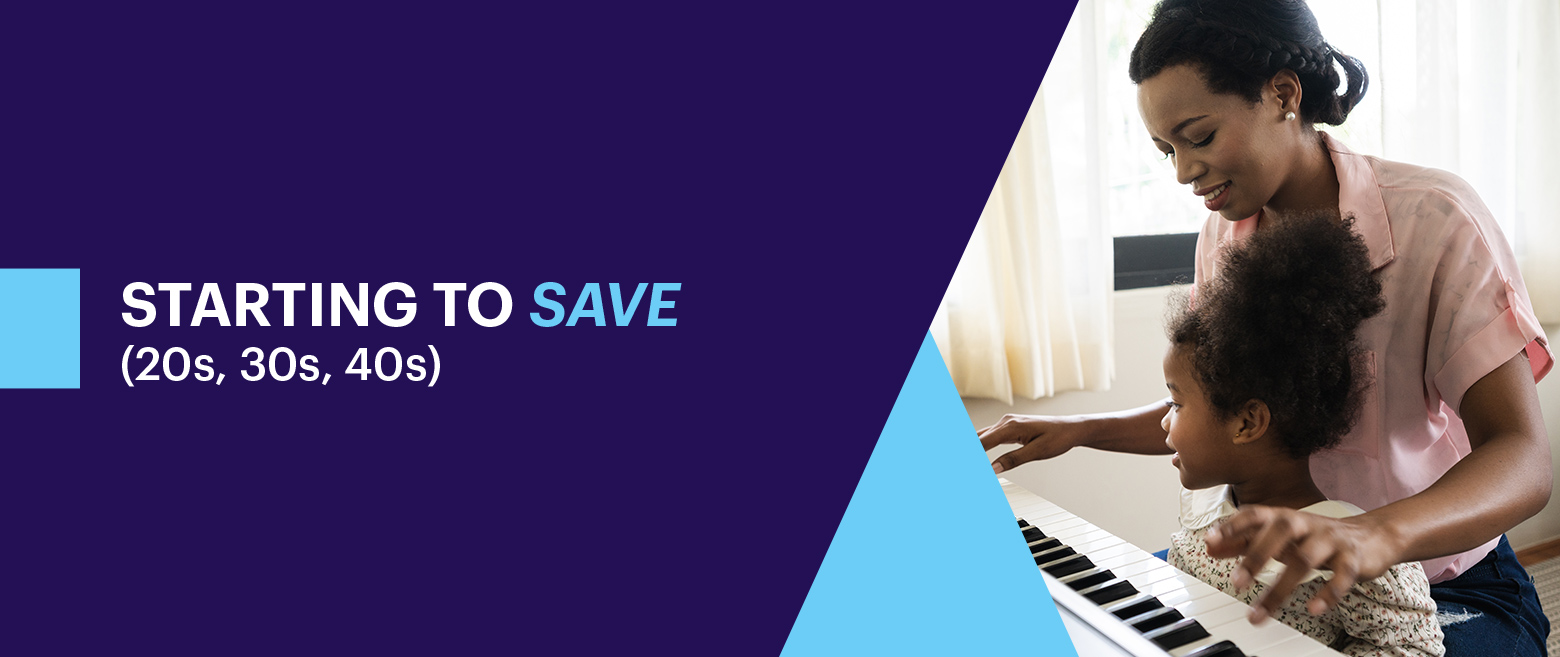Saving and planning for retirement in your 20s, 30s, 40s, 50s and beyond
Morgan Stanley Wealth Management
09/15/25Summary: Help your financial wellness with tips regarding retirement savings through different life stages.
The earlier you can start putting money away for post-work life, the easier it’ll likely be to pay for the retirement lifestyle that you want—when you want it. That said, it's never too late to put a plan in place and get started saving for retirement.
No matter your age, it's helpful to spend some time thinking about what your ideal retirement will look like. How old will you be when you call it quits? Will you work part-time? Maintain multiple homes? Travel the world?
While the answers to these questions will likely change over time, especially if you're still in the early stages of your career, considering them can provide motivation to save. Once you have goals in mind, the E*TRADE from Morgan Stanley Retirement Planning Calculator can help you create a personalized plan, track progress, and provide helpful tips to boost your outlook.1
Here are some tips on saving and investing for retirement, no matter your stage of life.

You likely have a lot of competing priorities during these years, including buying a home, starting a family, or simply trying to balance your budget and pay off student loans. While it's important to focus on these short-term milestones, establishing a realistic retirement savings plan can help in the long term.
Recognize the power of compound interest
The beauty of saving for retirement when you're young is that you've got decades for your money to potentially grow. This is prime time to put the power of compounding—the process of earning interest on your interest—to work. When you first open a retirement account, your initial deposit can grow by the percentage you earned in returns and/or interest annually; the next year, however, you have the potential to earn on the original amount you put in as well as the returns/interest you earned last year. It may not seem like much at first, but over time it can add up.
Prioritize your savings
Once you’re spending less than you earn, you can start directing your excess cash toward other financial goals. Consider this hierarchy as a start:
Consider life insurance
For people with dependents, especially young families, life insurance can be a critical part of a well-rounded financial plan. Term life insurance can provide your loved ones with a cash benefit2 (typically income-tax-free) in a worst-case scenario. They can use it to pay a mortgage, cover college tuition, keep a business running, or simply continue to help meet everyday expenses.

You're likely earning more money by now, but you may also be facing more financial responsibilities like children’s college tuition or caring for aging parents. Not to mention: Retirement is approaching, so you'll need to consider balancing your investing strategy to address your current needs while keeping an eye on the future.
Revisit your asset allocation
Diversifying investments across stocks, bonds, and cash can help you manage risk while maintaining growth potential. Being too conservative (e.g., staying in all cash) can be just as risky as being too aggressive, especially when factoring in inflation. Use the Allocation & Risk tool (login required) to understand the risk in your portfolio. It may also be important to rebalance your portfolio periodically as the markets or your goals change.
Streamline accounts
By the time you've reached this stage in your career, you may have built up multiple 401(k) plan accounts through former employers. Keeping your money in one place can make monitoring and allocating your assets much simpler—but consolidation is not right for everyone, so carefully consider your options. The E*TRADE from Morgan Stanley Rollover Tool can help you understand your options as you consider what to do.3
Make catch-up contributions
In 2025, if you’re age 50 or older (but not 60-63), you can contribute an additional $7,500 to your workplace retirement plan. Those age 60 to 63 can contribute a total $11,250 to their retirement plan. If you have an IRA and are age 50 or older, you can contribute an extra $1,000 to your account in catch-up contributions.

Once you've made it to retirement age, it's typically time to start shifting your focus from building up your nest egg to enjoying it. Of course, you'll want to make sure that the income stream you create not only meets your lifestyle needs now but can also cover future costs like healthcare.
Build a budget
Just as you did in your 20s, it’s important to make a budget reflecting your new financial picture to ensure that you’re still living below your means. Guaranteed income, such as from Social Security, pension benefits, or annuities can help pay for your essentials. However, if you can delay claiming Social Security, you can increase your benefit amount. A Morgan Stanley analysis finds that deferring Social Security can increase your benefit amount by the equivalent of a 6.3% annual return (October 2024).
Mind your RMDs
If you have a 401(k) plan, IRA, or other qualified retirement plan, the IRS requires that you take a required minimum distribution (RMD) from such accounts when you reach age 73.
Note, however, for a 401(k) plan or other qualified retirement plan (excluding IRAs), if you are still employed by the plan sponsor and are not a 5% owner, you may not need to take an RMD.
If you are over 59½ but have not yet reached RMD Age, you may want to “smooth out” the distributions. This means taking distributions from certain employer retirement accounts earlier in retirement (prior to reaching RMD Age) to lower account balances, which may help to prevent future RMDs resulting in higher income levels (that could push you into a higher tax bracket) in any given year.4
Look for growth potential
It's not uncommon for retirement to stretch three or four decades. That means you need to make sure your plan is flexible and can adapt with you over time to help you meet long-term needs and legacy goals.
Article Footnotes
1 The results generated by the Retirement Planning Calculator are hypothetical in nature, do not reflect actual investment results, and are not guarantees of future results.
2 Generally, life insurance proceeds received by a named beneficiary due to the death of an insured person are not includable in gross income and not reportable. Click here for more information. E*TRADE does not provide tax advice; please consult your tax advisor.
3 Distributions taken by an individual from certain employer retirement plans and IRAs prior to attaining age 59 ½ are subject to a 10% early withdrawal penalty tax, unless such distribution satisfies an eligible exemption to the early withdrawal rules.
4 RMD Age is (a) age 70 ½ for individuals born before July 1, 1949, (b) age 72 for individuals born after June 30, 1949, but before 1951, (c) age 73 for individuals born after 1950, but before 1960, or (d) age 75 for all others – note, apparent drafting error in the statutory language in in the SECURE 2.0 Act of 2022, which was signed into law on December 29, 2022, (“SECURE 2.0”) makes it unclear when age 75 starts to apply in lieu of age 73, but it appears age 76 is intended to apply if born after 1959.
5 All withdrawals from Individual Retirement Accounts will be considered distributions and reportable on IRS Form 1099-R. You must include all amounts you receive from the IRA in your gross income except amounts attributed to nondeductible contributions and amounts rolled back into an IRA or qualified plan. Federal and state income tax will not be withheld from payments from your E*TRADE Complete IRA using the checking, online bill pay or ATM/debit card features of the account, and it is your responsibility to make estimated tax payments if necessary. Withdrawals processed from your E*TRADE Complete IRA using the checking feature will be tax reported on IRS Form 1099-R for the year in which the funds are debited from your IRA after the check is cashed by the payee (even if the check was sent to the payee in the prior tax year). You expressly assume the responsibility for any adverse consequences that may arise from an IRA withdrawal and agree that Morgan Stanley Smith Barney LLC shall in no way be held responsible. Morgan Stanley Smith Barney LLC and its affiliates do not provide tax advice, and you always should consult your own tax advisor regarding your personal circumstances before taking any action that may have tax consequences.
6 Individual, joint and custodial accounts are eligible for the E*TRADE Complete™ Debit Card. In addition, certain IRA accounts are eligible if you are over age 59½. Not eligible are IRA accounts under age 59½, other retirement accounts, and business or investment club accounts.
CRC# 4723410 09/2025
How can E*TRADE from Morgan Stanley help?
Plan for your future
Explore easy-to-use planning tools and resources—designed to help you take control of your financial future.
Consider a retirement account
Invest in the future, with retirement accounts from E*TRADE.
E*TRADE CompleteTM IRA
For retirement investors over age 59½
Upgrade your account for flexible access to cash with free checking, online bill pay, and ATM/debit cards.d1, d2
Term life insurance
Click through a few simple questions to instantly get quotes from top-rated carriers.